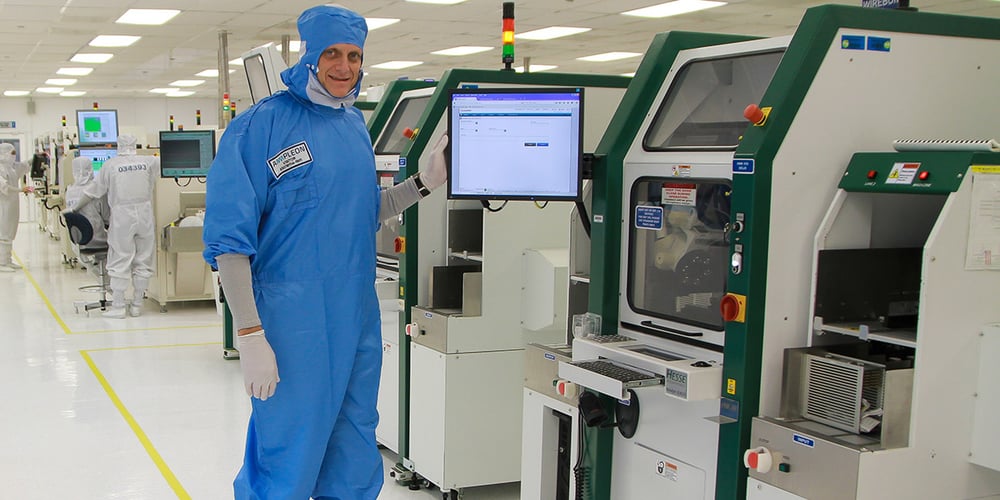Ampleon: riding the 5G wave with a smart factory
A leading global partner in RF Power products, Ampleon works on developing new 5G technologies, setting up the intelligent factory, and professionalizing its supply chain. The Factory Intelligence program is a roadmap to bring factory automation to the next level and to use data to increase performance and predictability levels. Ampleon’s Head of Global IT, Lody Hoekstra, talks about the journey, use cases, and challenges of modernizing the company’s factory.
Headquartered in Nijmegen, Ampleon is a global player in the area of RF Power. Its core business is the production of technology that amplifies communication signals for a wide range of applications, such as mobile broadband (3G, 4G, 5G), radio, and television broadcasting. The company was established in 2015 after NXP was required to carve out its RF Power business.
This carve-out meant that the new organization needed to establish a new IT environment within a short period. “An enormous challenge, but it also offered us a chance to improve and prepare for the future,” explains Lody Hoekstra, Head of Global IT at Ampleon. Hence, the company decided to build a scalable digital platform.
Ramping-up 5G
The completion of Ampleon’s new digital platform marked the start of a new chapter: a rapid ramp-up. Hoekstra: “5G technology was coming fast. In a short time, we needed to more than double our production capacity. This resulted in several challenges, with two key areas that we needed to focus on.”
“First, the supply chain. As we were scaling up our production, the demand for flexibility grew. Time-to-market needed to be reduced. We also required more insights and more control over the process.”
“In a short time, we needed to more than double our production capacity”
The second area that Ampleon needed to focus on was the factory itself. “We operate a factory which employs 1,200 people in the Philippines. And when you need to increase your manufacturing output that much, using new technologies, launching new products at a faster rate than ever before, this creates a tremendous challenge for the organization.”
Developing Factory Intelligence
Ampleon’s management posed the question: how can we modernize our factory? This question produced a list of conditions and goals, such as becoming paperless, decreasing the man-machine ratio, and full traceability of products. Lody: “80 % of these initiatives are IT-driven, and we recognized that we needed to prepare for this.”
Ampleon teamed up with the digital consultants of Itility to start the development of a new program: Factory Intelligence 2022. The starting point was to define concrete use cases that provide business value for Ampleon and translate those into a roadmap.
“Building a smarter factory involves using data. Lots of data,” says Hoekstra. The building of a data factory was, therefore, one of the first steps to take. Based on a central data lake, in which all Ampleon’s manufacturing data is collected, governed, and made available.
“You need a solid architecture, a technical configuration, and full integration. This process requires not only IT but domain expertise as well, combining the efforts of infrastructure engineers, data engineers, and business analysts.”
When building a data factory, it can be difficult to keep stakeholders involved. This was solved by using a roadmap to build for the future but focusing on small deliverables. Like a single data source or dashboard: things that immediately make people happy.
Use case: real-time OEE monitoring
Gathering data is step one, but the real goal is to use that data to improve daily operations. The challenge is to balance ambitious, long term improvements with deliverables that immediately provide value. One example of this is real-time OEE monitoring. “As a first step, we built a new factory-wide yield report and real-time monitoring of our Overall Equipment Effectiveness (OEE). Presenting data on machine uptime, usage, and performance in a way we can analyze it and take action.”
Hoekstra continues: “This tool is a great improvement compared to our previous systems. It provides immediate, actionable insights that are easily accessible for our entire organization. We now have a single source of truth for OEE information.”
Use case: traceability
End-to-end traceability is important, both for customers and Ampleon itself. “If a product is returned to us and we suspect it to be flawed, we want to be able to completely backtrack that product through our factory. Which machines did the product go through, in which phase? What values were measured at that time? If the cause of a flaw is confirmed, we can immediately identify which other clients might be impacted.”

Achieving this kind of traceability takes a big effort. Firstly, the manufacturing equipment itself. Ampleon uses industrialized IoT devices and smart machines to extract data. After disclosing this data, it is vital to know that people need to adjust as well. Operators who are used to look at a single machine need to adopt a holistic view. Change management is a big part of innovation.
Use case: predictive maintenance
Another important goal in Ampleon’s Factory Intelligence program is predictive maintenance. “We are working towards a scenario in which we know exactly when each machine was serviced, which components were replaced, and what the status is of components that are being used right now. We will use this information to predict when maintenance is necessary and optimize maintenance actions. This helps us to minimize a machine’s downtime, which creates a big cost saving. If minimizing downtime in combination with an optimized factory scheduling means we can deliver the same output with eighty percent of the machines previously required, that saves millions of euros.”
The first step in predictive maintenance is to make basic but important information available. For example: How many strokes have been made with a specific tool? This helps to replace the tool before it breaks down. Instead of basing maintenance on the time that has passed, you can use the real usage of a tool to replace it just in time. Preventing replacements that are unnecessary or too late. The next step is to actually use machine learning to even better predict when a replacement is needed.
Moving forward
Over the past years, Ampleon has successfully taken several major steps in their smart factory journey. As a result, Ampleon is already seeing a significant increase in its efficiency, quality, and output. “We would never have succeeded in multiplying our production in only a few years using our old way of working. Digitalizing our factory was not just a luxury, it is a necessity to prepare for Ampleon’s future.”
Looking at the future, Lody expects to see a lot of developments in the area of artificial intelligence. “There is a lot of potential if we can enable our software to identify risks and opportunities by itself. We are now working with data reporting and analysis. The next step is to automate the data analysis as well and use more complex algorithms to start predicting and prescribing.”
For more stories on how Itility customers create value by merging technology and data, check out our other use cases.





